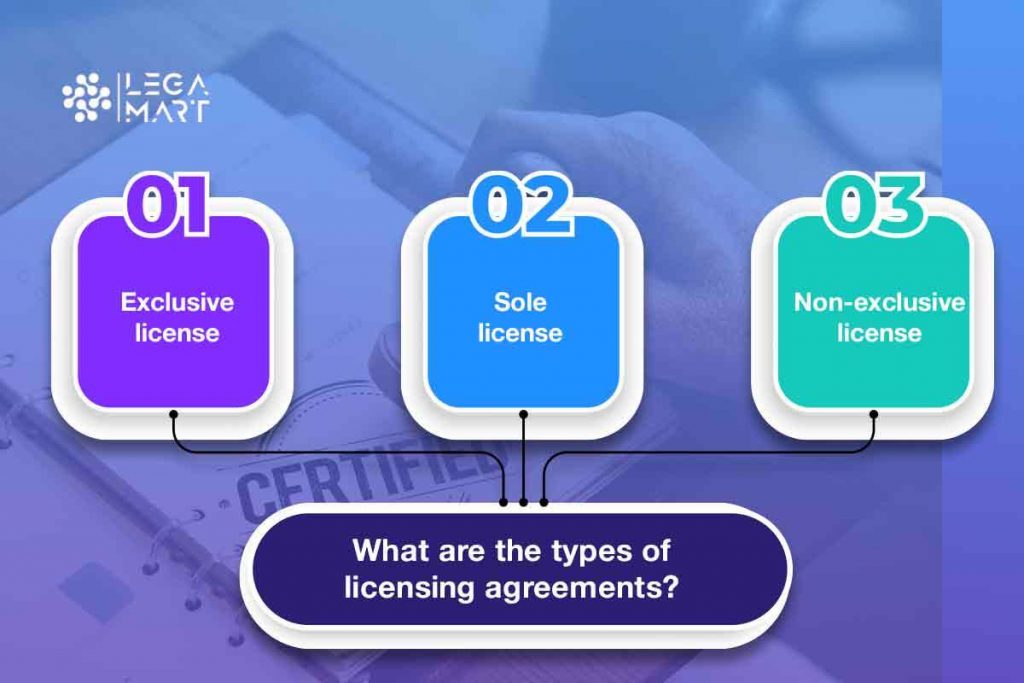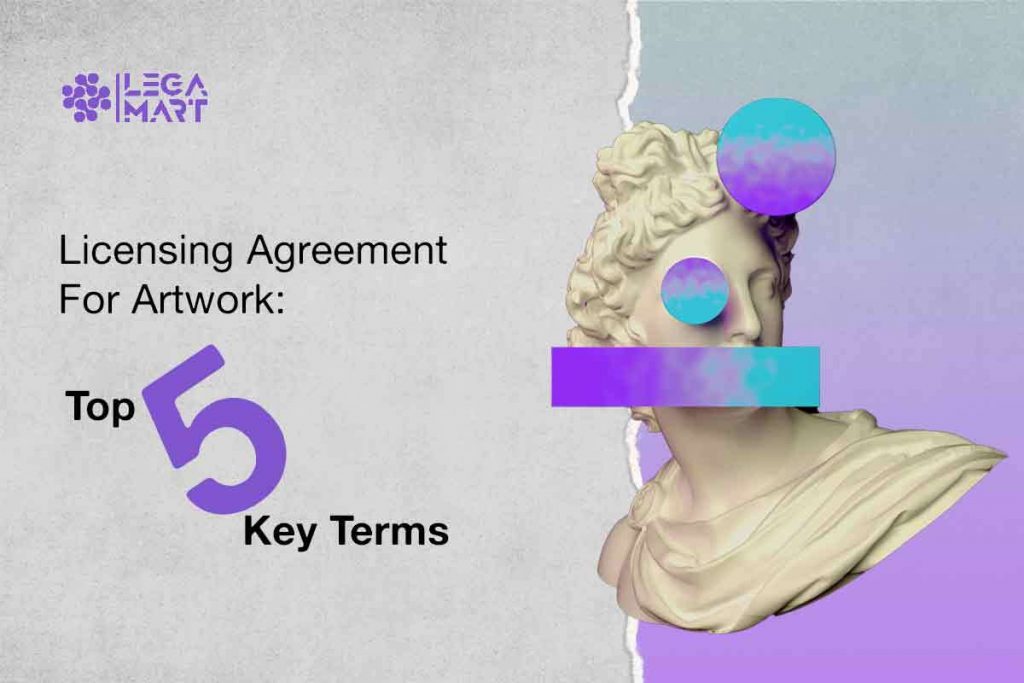- Introduction
- What are the benefits of entering into an artwork licensing agreement?
- What rights do copyrighted works belong to as per the copyright act?
- What are the elements of the licensing agreement?
- What are the types of licensing agreements?
- What are the due diligence issues to consider before entering a license agreement?
- Sample of licensing agreement
- What should I charge for art licensing?
- How do licensing agreements to help artists?
Introduction
A license agreement of artwork is a contract in which an artist grants permission to a client to use their work by granting them a license to promote an item or brand. The terms of the licensing agreement are unambiguous, as determined by the artist, making the requirements obvious as to how the licensee is authorised to use the work, and the artist gets the reward for its usage. If you’re interested to know more about licensing agreement as a whole, read the Article below:
However, artists usually neglect that they are entitled to have payments from collectors or customers for their works.
When an artist submits its work to a client for use, or a client contacts you regarding the usage of the work, this is wherein a license agreement plays an essential role in your protection and the originality of your work against a client who may use your work without your knowledge or consent.
To understand the importance of licensing agreement for artwork, we shall move to a situation-
Max (an author) publishes their book named “XYZ” in hard copies and on online platforms, which have gone through the procedure of the licensing agreement. As a result, he permitted several publishers, bookstores and online platforms to use his work and has reserved all rights to its original work.
Now, Maya(buyer) purchases XYZ from a bookstore, makes several copies of XYZ, and tries to sell XYZ in the market as an author to the same, hampering Max’s reputation and income.
Herein, Max filed a suit of copyright infringement against Maya. Max already has reserved all the rights of XYZ and permitted licensing agreements to several clients, wherein Maya was not included. The court held the case in favour of Max and penalised Maya for her act.
What are the Benefits of Entering Into an Artwork Licensing Agreement?
- Licensing forms a source of additional revenue stream to the licensor. An owner of the artwork can license the use of the works to as many licensees as possible and this creates an opportunity for additional revenue through royalties.
- Increased artwork recognition. licensing of artwork can be more about increasing customer recognition because, the more the work is used the greater is its recognition in the marketplace.
- Territorial expansion. Where a copyright owner allows another company or individual in a different territory to use his/her works through licensing such agreement allows the licensor to expand his/her/its territory.
What Rights Do Copyrighted Works Belong to As Per the Copyright Act?
Right to produce copies of your work
This is the most evident right obtained following copyright protection. This right allows the copyright owner to reproduce copies of the copyrighted work in any format. The author’s permission is necessary for reproducing a work unless evidence indicates that such reproduction is not intended to generate any commercial benefit.
Right to change or modify your work
The copyright owner can utilise his work in various ways, including modifications and translations. Making a movie based on a novel is an example of adaptation, and in this case, the authorisation of the owner is essential to create any derivative work. Certain other rights of the owner come into play in certain instances, such as the right to integrity, which protects the owner against distortion, defacement, or alteration of his work in a way that is detrimental to his reputation.
Right to distribute your work
The right to distribute the work is a subset of the right to reproduce. The copyright owner may distribute his work in any way he sees suitable. The owner may also transfer all or a portion of their rights to another individual. For example, the owner may permit anybody to use his work for translation purposes.
Right to publicly display your work
The copyright owner enjoys the right to perform their works publicly. For instance, the owner may present skits or perform at several events. It also includes the right to publish the work online.
Right to create offshoots of your work that are based initially on your work
This right allows a copyright owner to control in which way its work shall be performed “publicly”, which means the performance of a work is deemed public when it is broadcast in several venues, such as on television or radio. However, renting and showing a video in a public park or theatre without permission would breach the right. This right has the same concept mentioned above about the right to display the work.
What are the Elements of the Licensing Agreement?
- Licensing agreements are legal contracts between a licensor and a licensee.
- The contract specifies the sort of agreement, the duration of the agreement when payments and royalties are due, and the extent to which licensing is permitted.
- It also permits both parties to maintain control over some aspects of the transaction, such as confidentiality and how a product or service is promoted.
What are the Types of Licensing Agreements?

There are three types of licenses in artwork as highlighted below:
Exclusive license: in an exclusive license, the licensee is given the right to use
the artwork to the exclusion of all, including the licensor, such that the licensor agrees that the licensee is the only one who can make use of the artwork.
Thus, the owner cannot use the artwork or license any rights to third parties leaving the licensee as the only user of that work in the relevant market.
Non-exclusive license: in a non-exclusive license, the licensee is granted the right to use the artwork according to the grant, the licensor may continue to use the works as well as grant the license to other third parties.
Sole license: In a sole license, the licensor agrees to use just one licensee, while reserving the right to continue to use the artwork.
Commercial license: in a commercial license, the licensee is granted the right to use the artwork in commercial activities, such as merchandise, advertising, or branding. Further, this license opens the possibility of the artist gaining compensation/royalties dependent upon the commercial value of the artwork.
Non-Commercial license: in a non-commercial license, the licensee is only permitted to use the artwork for educational or not-for-profit work, which is not dependent on financial gains. These licenses are mainly provided for public good, and do not have any profit motive attached to them.
What are the Due Diligence Issues to Consider Before Entering a License Agreement?
Due diligence can be referred to as the performance of an investigation of a business structure or person. It is the first step done before entering into a business transaction, particularly when considering a long‐term business relationship like an IP license agreement. It must be done by both the licensor and the licensee. The exact information to be verified in a due diligence exercise varies. For instance, in Copyright (artworks), the basic information to be sought is as follows:
i) Identify all key copyright works owned by the company.
ii)Ownership of the artwork, particularly if the work was created by an employee as part of their job description, if the work was commissioned or if more than one person created the work.
iii) Check on employee and consultant agreements for acknowledgement of the status for copyright purposes and waive of moral rights.
ii) Identify any existing license agreements on the same Copyright or artwork and the type of license granted.
Clauses To Add to Your Licensing Agreement
The following clauses must be added to your licensing agreement:
- Grant of Rights – This clause provides details of the specific rights being granted to the licensee by the artist. The clause is inclusive of the details of the artwork, the usage permitted with the artwork (including details about the types of products that the art will be reproduced on, if applicable), the duration of the license, the territory within which the license is allowed, and the exclusivity terms (if any).
- Copyright – There must be a written clause between the artist and the licensee that the licensee shall put a copyright notice on every product sold, advertised, or brochure in relation to the artwork.
- Compensation and Royalties – This clause shall include the financial terms agreed between the parties, including details related to the royalty fee, license fee, and any other fee structure as may be applicable. Further, provide details on how the fee is calculated (can provide a fee schedule attached), along with details about product-specific royalties that the artist may gain.
- Usage and Quality Control – This clause shall provide details on how the artwork shall be used, along with details related to the size, format, watermarks, etc. The licensee shall be expected to adhere to these specifications at all times.
- Indemnification – This clause acts as a written agreement between the parties wherein the licensee agrees to indemnify the licensor for any potential lawsuits that might arise due to the licensee’s business activities about the artwork.
- Termination and Renewal/Cancellation – This clause provides various conditions which could lead to the termination of the agreement between the artist and the licensee. Alternatively, the clause can provide the option of renewal, extension or cancellation of the agreement once the duration ends. The options are provided by including notice period, termination fees, and other terms which might apply to renewal.
- Confidentiality – This clause helps protect information shared between the artist and the licensee during the licensee arrangement.
Sample of Licensing Agreement

THIS AGREEMENT is made the_____ day of
BETWEEN
(hereinafter called “the Artist”) of the one part
AND [ ], a limited liability company having its registered office and principal place of business at (hereinafter called “the Licensee”) of the other part
WHEREAS:
The licensee operates a business selling high-quality reproductions of original works of art.
The artist is the creator of original works of visual art and is willing to license the reproduction of specific artworks to the licensee on the terms herein contained.
IT IS HEREBY AGREED as follows:
Sole License
The artist hereby grants to the licensee a sole license to do any of the following things concerning the works of art specified in the First Schedule hereto (“the Artworks” ):
The Artworks will be reproduced as part of the licensee’s inventory, as described below:
To advertise for sale and to sell such reproductions to the public.
The artist acknowledges that the Licence herein being a sole Licence, the artist shall refrain from appointing another agent or third party to exercise any of the rights hereby granted in respect of the Artworks.
Manner of Reproduction
All reproductions for sale shall be Giclee onto printing canvas, stretched canvas, or archival paper.
All such reproductions shall be in full colour and shall be full size.
The licensee shall, however, be at liberty to make and publish (including on its website) reduced-size copies of the Artworks for only advertising the sale of the reproductions. In the case of online advertising, the copies shall be low-resolution copies.
Intellectual property
The original Artworks and their copyrights remain vested in the artist, subject to the terms of this agreement. No rights in the Artworks, other than those herein licensed, shall be exercised by the licensee. Additionally, any copyright agreement must include critical elements like the scope and nature of the license related to IP.
Navigating the intricacies of licensing agreements is essential in protecting intellectual property. However, as the digital landscape evolves, it’s imperative to recognize the potential pitfalls on social media. Unauthorized sharing or reproduction on the social media platforms can inadvertently lead to copyright infringement, underscoring the importance of aligning licensing strategies with the dynamics of the digital age.
Sale of original work
In the event of the sale of the original artwork, the artist shall make the purchaser aware of the terms of this agreement.
Territory
The rights hereby granted may be exercised by the licensee in any part of the world.
Term
Subject to the termination provisions contained in clause 13 below, the term of this agreement shall be two years from the date hereof
Obligations of the Licensee
The licensee shall, during the term of this agreement, actively promote the sale of reproductions of the artworks and, in general, shall seek to exercise the rights hereby granted to the advantage of both parties.
Sale Price
The licensor shall be at liberty to fix the sale price of the reproductions.
Royalties
The licensee shall pay the licensor [ ] % of the gross value of the sale of each reproduction of the Artworks (excluding VAT), or [] per reproduction, whichever is greater.
The licensee shall keep proper records of all income earned in connection with the Artworks and shall account to the artist twice yearly while discharging all monies then due to the artist by the licensee.
The licensee shall, upon 14 days’ notice, permit the artist to inspect all records of the licensee relating to the exercise of the rights at this moment granted.
Warranty and Indemnity
The artist warrants that they are the creator of the original artwork.
That all rights, including the copyright, in the said works, are vested exclusively in the artist; that the artist has full right and authority to enter into this agreement and that the use of the Artworks in the manner envisaged by this agreement will not to the knowledge of the artist infringe the rights of any third party.
The artist further indemnifies the licensee against all costs and demands claims and proceedings arising concerning a breach of this warranty. The provisions of this clause shall survive termination of this agreement.
Moral Rights
The licensee undertakes to respect and observe the artist’s moral rights of paternity (the right to be identified as the creator of the work) and integrity (the right to preserve the work from derogatory mutilation and distortion.
Termination
Either party may terminate this agreement by giving the other party three months’ notice in writing if no income is realised from the Artworks through the licensee’s efforts for three consecutive months.
Either party may terminate this agreement in case of a material breach of the terms hereof by the other party.
This agreement shall automatically determine in the event of the insolvency of the other party.
Termination shall be without prejudice to the right of either party to redress for any antecedent breach of this agreement.
In the event of termination of this agreement, whether by the expiration of the term granted hereunder or for any other reason, the licensee shall cease to exercise the rights granted hereunder. The licensee shall deliver to the licensee all unsold reproductions in possession of the licensee upon payment by the licensor for the direct costs of work reproduction incurred by the licensee, to be vouched by the licensee.
Successors
This agreement binds and ensures the benefit of the parties hereto, and (in the case of the artist) their executors and assigns, and (in the case of the licensee) its successors and assigns.
Confidentiality
The artist agrees to keep confidential the key terms of the licensing agreement.
General
This agreement is personal to the parties hereto and may not be assigned by either party without the prior written consent of the other party.
Following the terms of this agreement, any notice shall be sent by registered mail to the recipient at the address indicated on page 1 of this agreement or such other address as may have been notified to the party giving the notice.
The parties agree to mediate any dispute relating to the terms of this agreement, using a single mediator acceptable to both parties and in default of the agreement to be appointed by the President for the time being of the Mediators’ Institute of Ireland.
Any amendment must be in writing and signed by both parties.
This agreement constitutes the agreement between the parties and supersedes all prior negotiations and understandings.
IN WITNESS whereof the parties hereto have executed this agreement the day and year first herein written…
What Should I Charge for Art Licensing?
The frequent methods deployed for charging in the case of art licensing are:
Royalty- Royalty rates are determined based on the market, different types of products, and expected sales volume. It is calculated by multiplying the rate by net sales. Artists receive 4%- 30% royalties on the actual price of the products. If you are a well-known licensing artist and your artwork attracts more audience and sales, the royalty rates would be at the higher end of the scale. One prominent suggestion is that an artist must negotiate for the best offer on the quality of the work produced.
Flat Fee- The lump sum payment is paid beforehand when signing the agreement. This method is suitable for companies with a low sales track record. The flat fee amount is subject to the willingness of the licensee to pay, competition in the industry, and the brand’s strength.
Royalty with advance upfront- This is an excellent method as an artist is paid in advance at the start of the contract and is non-refundable. It is equivalent to 5%-10% of the overall expected royalties over the entire duration of the license contract. Licensing often involves delayed or no royalties depending upon the sales and branding of the products. It acts as insurance if the license does not generate any royalties in the future. This amount is later deducted from future royalties.
How do Licensing Agreements to Help Artists?
Licensing agreement provides advantages to the artists, such as protection and propriety of their work. This agreement entails the terms of the commercial usage of the artwork and determines the actual compensation for the artist’s benefit. It acts as a safeguard against the client that uses the artwork without prior permission in an unapproved manner. Artwork licensing helps artists generate passive income without relinquishing the copyright of their work. Further, they get access to new foreign markets and geographical regions by efficiently utilising the licensee’s distribution network.
Yes, US Copyright may be provided protection and international acknowledgement in certain foreign countries. This can be determined based on international copyright relations maintained by the US Copyright office. Circular 38A by international copyright relations is a crucial document that elaborates comprehensive information on the copyright agreements of each country with the US. It obligates the mentioned countries to recognise the US citizen’s copyrights.
In the International context, the Berne Copyright Convention provides the minimum protection, and exceptions to copyright law will be as per the exceptions test laid down by Berne.
Apart from this, as per the Berne Convention, it is not mandatory to incorporate the © symbol to invoke protection. Further, no registration of work with the government copyright office is needed to be done by Berne member countries.
If you want to protect your US copyright under the UCC, you must use notice © [year of publication][auther or copyright owner].
Drafting and Decoding a licensing agreement are challenging tasks which an experienced intellectual property lawyer can only handle. If you are confused about how to do it, you have come to the right place. With LegaMart, you can find the best lawyers before your computer or phone screen. You read it right.
LegaMart contains a database of 1000+ lawyers from more than 100 countries. So, what are you waiting for?
Frequently Asked Questions
What is a licensing agreement for artwork?
A licensing agreement for artwork is a legal contract where the artist grants permission to another party to use their work under specified terms. This often involves the use of the art for commercial purposes.
What are the key terms in a licensing agreement for artwork?
The top five key terms include:
- Scope of License: Describes how, where, and for what purpose the artwork can be used.
- Duration of License: Specifies the timeframe during which the licensee has the rights to use the artwork.
- Royalties: Details the financial arrangement, often a percentage, that the licensor receives from the licensee’s use of the artwork.
- Territory: Defines the geographical area where the licensee is permitted to use the artwork.
- Termination Clause: Outlines conditions under which the agreement can be terminated, protecting both parties.
Why is the scope of the license essential?
The scope of the license defines the boundaries of use, preventing misuse or unauthorized exploitation of the artwork. It ensures clarity and mutual understanding between the licensor and licensee.
How does the duration of the license impact the agreement?
The duration of the license sets the timeframe for the licensee’s rights. Both parties must agree on a defined period, preventing indefinite use and allowing for renegotiation or termination.
What role do royalties play in a licensing agreement?
Royalties determine the financial compensation the licensor receives. It’s a key term influencing the economic aspect of the agreement, ensuring fair compensation for the use of the artist’s work.




